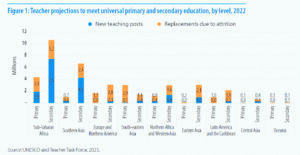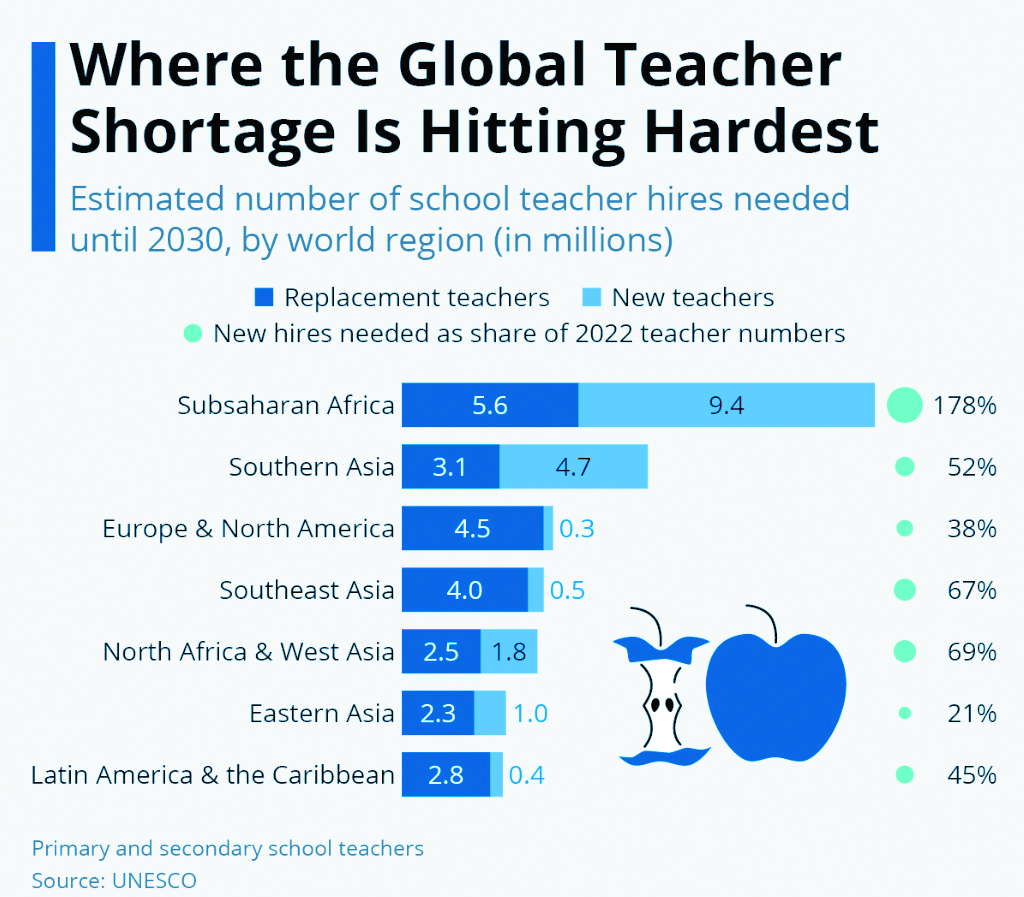A recent UNESCO report underscores the global nature of teacher shortages. The issue is often linked to ageing societies compensating for retirements, while simultaneously, growing regions are set to hire numerous new teachers by 2030. Both scenarios pose significant challenges due to the scarcity of teaching professionals, particularly in the developing world, where new hire projections can exceed the entire teacher stock of a region.


In Europe and North America, the demand is substantial, with 4.8 million teachers projected to be hired by 2030. The majority of these positions aim to replace retiring or departing teachers, constituting 38% of the 2022 teacher stock in the region. Similar situations are observed in Southeast Asia, Latin America, and the Caribbean. Eastern Asia, focused on hiring replacement and new teachers, has the lowest proportion of new hires needed concerning the 2022 teacher stock, standing at 21%.
Contrastingly, Subsaharan Africa and Southern Asia face a different scenario. The regions, still experiencing population growth, require more new teacher positions due to larger cohorts entering school age. Subsaharan Africa anticipates hires equivalent to 178% of its 2022 teacher stock, surpassing the number of teachers it had in 2022. Southern Asia, despite needing 4.7 million entirely new teachers by 2030 (with 3.1 million replacements), stands at 52%. UNESCO emphasizes the need for countries with growing populations, like those in Subsaharan Africa and Southern Asia, to enhance the appeal of the teaching profession for effective recruitment and retention. The report suggests that Subsaharan Africa may struggle to meet its hiring target by 2030.
Teacher projections
Efforts to meet universal primary and secondary education goals by 2030 face a significant hurdle, as projections indicate a global shortage of 44 million teachers.
Although this marks a reduction from the 2016 estimate of 69 million, the progress falls short, with an ongoing need for two additional teachers for every one recruited since 2016. Progress in recruiting and professionalizing teachers varies widely across regions.
As the world reaches the midpoint of the Sustainable Development Goals (SDG) era, Northern Africa, Western Asia, and South-eastern Asia encounter challenges in achieving teacher recruitment targets. These regions collectively require an additional 4.3 million and 4.5 million teachers.
Sub-Saharan Africa faces a more critical situation, with a demand for 15 million additional teachers. The current recruitment targets in these regions are only 70% of the 2016 goals, raising concerns about the feasibility of achieving the targets by 2030.
Secondary education needs more teachers than primary education
Globally, the demand for teachers by 2030 illustrates a stark contrast between primary and secondary education. A total of 13 million additional primary teachers are required compared to 31 million for secondary education, representing a ratio of 7 out of 10.
The situation intensifies in sub-Saharan Africa, where the need for secondary education teachers surpasses that of primary education. A staggering 10.7 million secondary teachers are required, more than twice the demand for primary teachers, which stands at 4.4 million.
Southern Asia faces a similar trend, with a wider gap between the need for secondary and primary education teachers. The region requires 6.7 million secondary teachers compared to 1.1 million for primary education.
Teacher attrition is a global challenge
Global attrition rates among primary teachers almost doubled from 4.62 per cent in 2015 to 9.06 in 2022; in lower secondary education, it increased substantially in 2020 but has since begun to decrease. While recent data for upper secondary attrition is lacking, older UIS data generally show that attrition decreases at higher levels of education.
Global disparities in teacher attrition rates
Teacher attrition rates exhibit significant disparities worldwide, with variations between countries and educational levels. The reasons for high or low attrition rates remain unclear, and multiple factors contribute to these discrepancies.
Between 2019 and 2021, Sierra Leone reported notably high primary teacher attrition rates of 17%, 5%, and 21%, while Georgia experienced lower rates of 12%, 5%, and 4% during the same period. The intricacies of attrition within countries are influenced by factors such as poverty rates, remote locations, and emergencies.
From 2020 to 2022, primary-level teacher attrition exceeding 10% occurred in various countries globally. Sri Lanka recorded 10%, the British Virgin Islands and Côte d’Ivoire 11%, Honduras, Jordan, and Lebanon 12%, Mauritania 16%, and Rwanda 19%. Alarming rates of 20% or more were reported in Benin (28%), Sierra Leone (21%), and Turks and Caicos (25%). In sub-Saharan Africa, high attrition persists, but some countries show a decreasing trend due to limited alternative employment opportunities.
Conversely, certain countries exhibited low primary attrition rates, 3% or under. China, Macao SAR, Egypt, Mauritius, Mongolia, Nepal, and the Solomon Islands reported 1%, while India, Micronesia, Morocco, Niger, and Vietnam reported 2%. At 3%, the Marshall Islands and Tonga maintained low attrition rates. Overall, UIS data indicate slightly lower attrition levels at lower education stages, although significant variations exist between countries.
Specific instances, such as Honduras, Mauritania, Myanmar, and Sierra Leone, showcase higher primary attrition rates than secondary levels. Conversely, Burkina Faso, Micronesia, and Nepal exhibit higher secondary attrition rates. In upper-middle- and high-income countries in Europe and Latin America, evidence suggests that secondary-level attrition rates surpass those at the primary level in seven out of nine countries.
Teacher attrition and gender inequality
Male teachers exhibit higher attrition rates compared to their female counterparts, with global rates in 2021 at 9.2% for male primary teachers and 5.9% for male lower secondary teachers. In contrast, female teachers experienced lower rates, with 4.2% for primary and 5.6% for lower secondary.
Various factors contribute to higher male attrition, including greater employment mobility, especially in sectors like construction, business, manufacturing, and agriculture.
The global gender gap in labour force participation, standing at 25%, leads to women being overrepresented in lower-paying service sectors, including education. Cultural norms and gender bias also contribute to teaching at lower education levels being perceived as a predominantly women’s profession.
This trend has intensified over the years, evident in the growing representation of women in teaching. In 2000, female pre-primary teachers comprised 92% of the global teaching force, increasing to 94% in 2022.
NOTABLE ASPECTS:
• Globally, 44 million additional teachers need to be recruited to meet universal primary and secondary education in 2030 of which 1 in 3, or 15 million, are needed in sub-Saharan Africa alone – a number which has decreased by only 2 million since 2016.
• Secondary education needs more teachers than primary education – about 7 out of 10 recruits globally. This is particularly so in Southern Asia and sub-Saharan Africa where many new secondary level teacher posts will need to be filled to meet the requirements of expanding education systems.
• Attrition among primary teachers almost doubled from 4.62 per cent globally in 2015 to 9.06 in 2022; moreover, the global male primary attrition rate in 2021 was 9.2 per cent compared to the female rate of 4.2.
• Only half of all countries pay primary teachers more than other professions requiring similar qualifications, while this decreases to just 3 in 10 countries in Europe and Northern America.
• Teacher shortage is a global phenomenon, affecting developing and developed countries alike. In Europe and Northern America, retirement and a lack of interest in entering the profession pose challenges to ensuring the recruitment of 4.8 million teachers needed to secure quality primary and secondary education for all.






